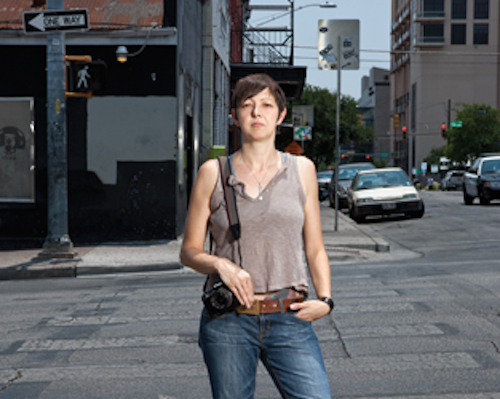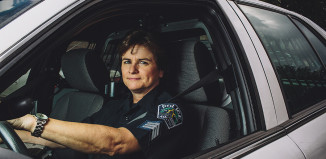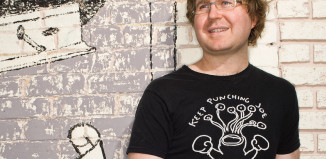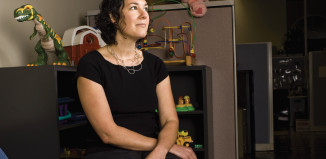In the heat of the summer, back in August of 2006, JoAnn Santangelo was a newly minted resident of Austin, having left Boston—where she was born and raised in that city’s Italian North End neighborhood—for new opportunities. For someone who had been snapping photographs since the age of 10, it was natural for her to spend time biking and walking around her new city with camera in tow.
At first, she’d ride her bike everywhere and photograph things. Early one Sunday evening, however, as she was riding home from Whole Foods Market, her bike broke down. At the corner of Red River and East 7th Street, admittedly home to many a character, she saw a striking young woman whom she wanted to photograph.
“Hopefully, our paths will cross again. I’d love to give you a print,” Santangelo said.
A week later, their paths crossed again outside a coffee shop downtown, where Santangelo learned that the woman, named Ariana, worked at Buffalo Exchange. Shortly thereafter, Santangelo went to Buffalo Exchange to give her a print. The woman looked at it and began to cry. “This is beautiful, and I haven’t seen a picture of myself in five years.”
What Santangelo has come to realize, in photographing hundreds of people all over the country during the course of her career, is that people want—indeed, crave—the knowledge and self-awareness that comes with sharing their stories and being photographed. She makes certain that her contact with them is more than a drive-by conversation. “I enjoy learning about peoples’ lives,” she said, adding that she photographed Ariana several more times over the next few months. “When you talk to people, everyone has a story.”
Her first professional camera, a Nikon F100, was a gift from her then-girlfriend and her parents who pooled their funds to buy it from the camera shop in Boston where she was working. Living in the type of closely knit urban neighborhood where everyone knows your name, Santangelo would snap pictures of characters in Boston; however, she didn’t like having her own photo taken and was rather shy growing up. As a great math student (“Photography is partly about numbers”) and a serious basketball player, she received a scholarship to Bentley University, a top-ranked business school in Waltham, Massachusetts. Nevertheless, Santangelo was miserable and dropped out shortly thereafter.
Education that aligned with her passion, however, was vital. In 2008, Santangelo applied to, and was accepted into, the photojournalism program at the International Center of Photography. Its unique, underground building is on Fifth Avenue in Manhattan. In a separate building across the street, the ICP has a collection of 100,000 photographs and puts on rotating exhibits. The ICP’s one-year, highly intense degree program is a baptism by fire. (Typical first-term assignments: Stand on a street corner, once a week for 10 weeks, and photograph it for two hours.Ridethesubwayforacertainlengthoftime and take as many photos as you can.) Because of her love of the darkroom and her obsession with black-and-white photography, Santangelo shot all of her pictures on film, as opposed to digital. For the second semester, students worked on an independent project of their choosing.
For her project, Santangelo chose to photograph LGBT veterans who had served prior to or under the military’s Don’t Ask, Don’t Tell ban on LGBT service members. While driving her pedicab around Austin one late night before she left for school, she picked up a young man on Congress Avenue. This was during the height of the Iraq War and, as she paused in front of the Capitol Building, he poured out his heart to her. “This one kid was by himself and he’s crying,” said Santangelo. “He tells me how he lost his friends, he’s only 22, he doesn’t want to go back, but the military is giving him more money. Also, he’s like, ‘I’m gay. You have no idea what it’s like to be gay in the military.’”
He was right; she had absolutely no idea. But the emotional impact of that conversation stuck with her long after she dropped him off at his hotel downtown.
At ICP, she’d done a ton of research to back up her work, but the hard part would be finding participants who were willing to be open and allow Santangelo into their lives and homes. She connected with an advocacy group called American Veterans for Equal Rights. Her first subject, Nicole, a resident of Manhattan, was an older trans-woman who had served as a medic in the U.S. Army as a man in the Vietnam War. She attended a Servicemembers Legal Defense Network (SLDN) rally in Washington, D.C., that called for the repeal of DADT. This led to meeting another five participants, including Lt. Dan Choi, who had just come out publicly on The Rachel Maddow Show.
Santangelo had been contacted by Ector Simpson from the LGBT Community Center in Manhattan regarding her compelling series of black-and-white portraits of LGBT homeless youth, sex workers and characters of the Christopher Street piers in the West Village. Having seen some of the veterans portraits on her website, he said that if she could find 15 more participants, he’d host an exhibit on Veteran’s Day at the LGBT Community Center. At that point, in a year and a half of trying, she had only 20 portraits.
When Santangelo attended Servicemembers United Veterans Lobby Day in May 2010, a massive awareness and advocacy event in the nation’s capital, she met dozens of people who had expressed interest in being photographed, but they were spread throughout the country. Like most artists, she was struggling to make ends meet. So after mounting a successful campaign on Kickstarter that raised $3,305, she took a road trip, drove 10,000 miles and photographed 46 LGBT veterans in 26 days. The result of all that hard work was an exhibit opening at the LGBT Community Center— that prompted a panel on the topic of serving openly in the military. The panel, in November 2010, brought Santangelo head-to-head with some nationally known figures fighting for the repeal of DADT. The moderator was Richard Socarides, who served as White House Special Assistant and Senior Advisor during the Clinton Administration. Panelists included Jonathan Capehart, the openly gay Pulitzer Prize– winning Washington Post journalist and MSNBC contributor; Winne Stachelberg, of the Center for American Progress; and Dr. Nathaniel Frank, author of Unfriendly Fire: How the Gay Ban Undermines the Military and Weakens America. All the commentators said that President Obama needed to learn the personal stories of people dealing with the misguided policy.
“Here’s 65 stories and faces of DADT,” enthused Santangelo, adding that her contact, Stachelberg, reported back three months later to say that Obama was “deeply moved.” She also received a thank-you note from the White House.
High-profile hobnobbing notwithstanding, Santangelo is generally quiet and drawn to things and people at the margins of society. The eagerness to capture the spirit of underrepresented people led her to piers on Manhattan’s west side, where she photographed countless African-American and Hispanic LGBT youth who spent a good part of their evenings walking those streets. The resulting exhibit of large-scale black-and-white photographs, Walking the Block: Christopher Street, showed at the B. Hollyman Gallery here in Austin. “Most people who I do end up photographing have in some way been assaulted, verbally or not,” said Santangelo, adding that she was called names growing up. “Inside, I felt like I had all these feelings that nobody asked me about—one of them being my sexuality.”
Burnes Hollyman, owner of B. Hollyman Gallery, was effusive in his praise of Santangelo. His gallery was the first to give her a full solo show in Austin, and it’s clearly a decision he’s proud of. “Stripped down to the basics, JoAnn has talent on loan from God. She sees true things and captures them very directly,” he said. “Her work is stunningly bold and strong, elegant and eloquent, passionate and compassionate.”
Ultimately, she won the trust of her subjects— who were used to scrutiny, but from police officers rather than photojournalists—and captured people living in a streetscape that doesn’t exist anymore. “Everything that’s on that block is gone now,” she said. “Chi-Chi’s [an old-school, primarily African-American gay bar] is gone; the sex shop is gone. It’s a moment in time.”
Beyond plans to travel to Europe with her wife, Kate Payne (they were legally wed in New York City in June and are preparing for a ceremony for friends and family in September in Austin), Santangelo is working hard on a project for the Sustainable Food Center that will document the full life cycle of food from farm to plate. The couple loves to cook meals together and take in the city’s cultural and artistic offerings, and Santangelo still enjoys riding her bike around town and snapping pictures of the locals.
“Her documentary work is deeply beautiful because it reflects her very personal connection with the people she photographs,” continued Hollyman. “There are thousands of documentary photographers out there, but what makes her uniquely different is simply two things: her eyes and her heart.”
Additional images provided by JoAnn Santangelo.
Black and white images from the series Walking the Block: an exploration of Christopher Street after dark.
Apollo
Apollo, a self-described male escort, has been working the streets since the age of 15. Photo was taken May 2009 in front of Chi Chiz Bar (which is now closed) on Christopher Street in New York City’s West Village.
Kat Eyes
After we were told by the police to move along, Kat Eyes, who has been working the streets since her early twenties, poses on Greenwich Street in New York City’s West Village. Photo was taken in August of 2009.
From the series Proud to Serve: Portraits of Lesbian, Gay, Bisexual and Transgender Veterans
Lt. Gen. Denise Jacinto (R) and Lt. Col. Sharrie Russell (L) each served in the Army Military Police Corps. Denise served from 1976 to 1996. She was one of the first women assigned to a combat division. Sharrie served from 1974 to 1995. She was the former commander ofa 1,200-soldier battalion. Both ended their military careers, retiring in order to be together. They have been a couple for 19 years. Photo was taken August 2010 at their home in Lincoln, AL.




































